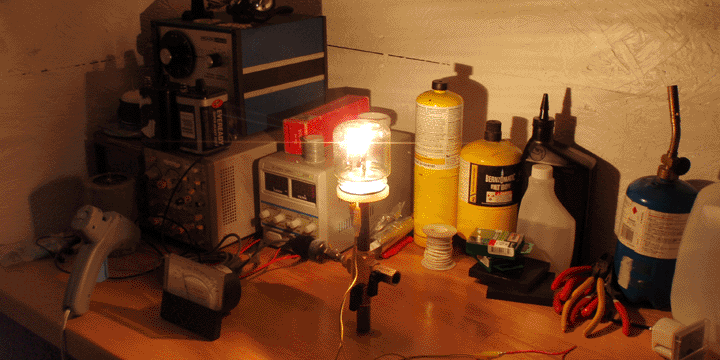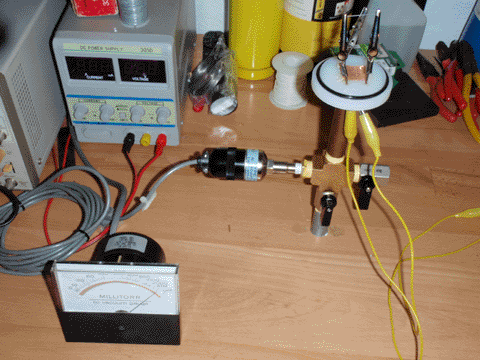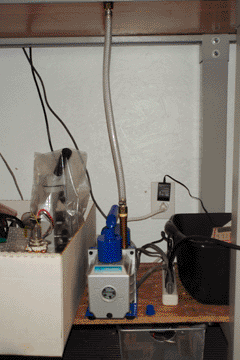
My next project will be the manufacture of vacuum tubes. This will be a large undertaking, and many previous projects have led up to it. The first step towards this has been to assemble a vacuum chamber for the testing of tube designs.
The pump is a Chinese rotary vane pump for servicing AC units. I bought it because only cost $100 and claimed an extraordinarily high vacuum of 0.3 pascals (around 2 millitorr). This does not appear to be a mistake; after replacing the pump stem with a straight 3/8 NPT pipe and adjusting the check valves inside the pump body, it easily reached between 1 and 5 millitorr at the pump head, and around 10 millitorr with the full chamber assembly attached.
I initially had the manifold directly connected to the pump body, but the vibrations from the pump quickly shook apart anything assembled inside the chamber. The manifold is now connected to the pump via a steel-reinforced vinyl hose, which mechanically decouples the pump and the chamber. The valves are simple teflon-seated ball valves, and all connections are sealed with teflon tape, aside from the connection between the pump and the pipe which is sealed with thread-locker. The vacuum gauge is a Varian 531 thermocouple gauge, connected to a panel meter which came with it. This required a lot of calibration, and perhaps a capacitive manometer may have been a better choice.
The chamber base is simply a disc of polyethylene with a step machined around the edge for an o-ring to sit on. A large hole is in the center, tapped to receive a 3/8 NPT pipe, and covered with copper mesh to stop small objects from falling into the pump. Smaller holes are drilled around this center hole for copper wire feedthroughs. Both the mesh and the feedthroughs are sealed with hot glue. The chamber itself is an ordinary glass jar, with the seal to the o-ring being made airtight with vacuum pump oil.
Despite the amateur nature of the whole assembly and the use of gassy materials such as plastic and hot glue, it achieves an adequate vacuum for a large number of experiments. I have successfully deposited copper, titanium, and magnesium onto the inside of the chamber, and have used a graphite pencil lead and various bits of metal to make a light bulb (pictured above), a diode, and a triode. In future work I intend to make sealed off versions of these devices and write articles on their manufacture.
Below are two pictures of the entire system. If I were to do this project again, I would probably leave the original stem on the pump. Replacing it with the straight pipe was more difficult than expected, and caused more problems than I believe it solved. Regardless, it operates well now.

